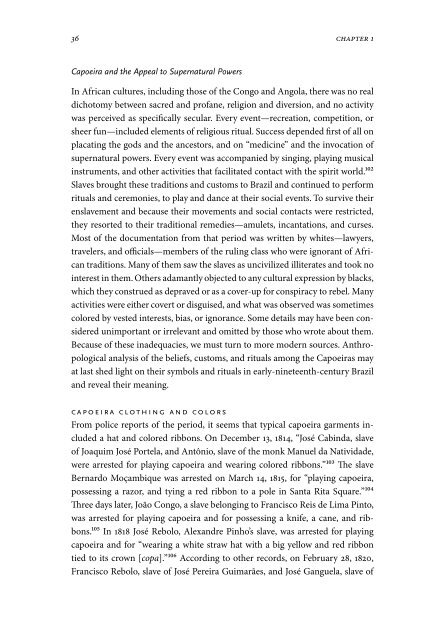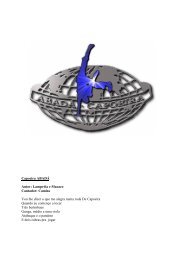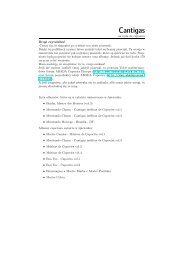A Collision of Cultures in the Brazilian Battle Dance - Capoeira Music
A Collision of Cultures in the Brazilian Battle Dance - Capoeira Music
A Collision of Cultures in the Brazilian Battle Dance - Capoeira Music
Create successful ePaper yourself
Turn your PDF publications into a flip-book with our unique Google optimized e-Paper software.
6 chapter<br />
<strong>Capoeira</strong> and <strong>the</strong> Appeal to Supernatural Powers<br />
<strong>in</strong> african cultures, <strong>in</strong>clud<strong>in</strong>g those <strong>of</strong> <strong>the</strong> Congo and angola, <strong>the</strong>re was no real<br />
dichotomy between sacred and pr<strong>of</strong>ane, religion and diversion, and no activity<br />
was perceived as specifically secular. every event—recreation, competition, or<br />
sheer fun—<strong>in</strong>cluded elements <strong>of</strong> religious ritual. success depended first <strong>of</strong> all on<br />
placat<strong>in</strong>g <strong>the</strong> gods and <strong>the</strong> ancestors, and on “medic<strong>in</strong>e” and <strong>the</strong> <strong>in</strong>vocation <strong>of</strong><br />
supernatural powers. every event was accompanied by s<strong>in</strong>g<strong>in</strong>g, play<strong>in</strong>g musical<br />
<strong>in</strong>struments, and o<strong>the</strong>r activities that facilitated contact with <strong>the</strong> spirit world.102<br />
slaves brought <strong>the</strong>se traditions and customs to Brazil and cont<strong>in</strong>ued to perform<br />
rituals and ceremonies, to play and dance at <strong>the</strong>ir social events. to survive <strong>the</strong>ir<br />
enslavement and because <strong>the</strong>ir movements and social contacts were restricted,<br />
<strong>the</strong>y resorted to <strong>the</strong>ir traditional remedies—amulets, <strong>in</strong>cantations, and curses.<br />
Most <strong>of</strong> <strong>the</strong> documentation from that period was written by whites—lawyers,<br />
travelers, and <strong>of</strong>ficials—members <strong>of</strong> <strong>the</strong> rul<strong>in</strong>g class who were ignorant <strong>of</strong> african<br />
traditions. Many <strong>of</strong> <strong>the</strong>m saw <strong>the</strong> slaves as uncivilized illiterates and took no<br />
<strong>in</strong>terest <strong>in</strong> <strong>the</strong>m. o<strong>the</strong>rs adamantly objected to any cultural expression by blacks,<br />
which <strong>the</strong>y construed as depraved or as a cover-up for conspiracy to rebel. Many<br />
activities were ei<strong>the</strong>r covert or disguised, and what was observed was sometimes<br />
colored by vested <strong>in</strong>terests, bias, or ignorance. some details may have been considered<br />
unimportant or irrelevant and omitted by those who wrote about <strong>the</strong>m.<br />
Because <strong>of</strong> <strong>the</strong>se <strong>in</strong>adequacies, we must turn to more modern sources. anthropological<br />
analysis <strong>of</strong> <strong>the</strong> beliefs, customs, and rituals among <strong>the</strong> <strong>Capoeira</strong>s may<br />
at last shed light on <strong>the</strong>ir symbols and rituals <strong>in</strong> early-n<strong>in</strong>eteenth-century Brazil<br />
and reveal <strong>the</strong>ir mean<strong>in</strong>g.<br />
CaPoeira Cloth<strong>in</strong>g and Colors<br />
from police reports <strong>of</strong> <strong>the</strong> period, it seems that typical capoeira garments <strong>in</strong>cluded<br />
a hat and colored ribbons. on december 13, 1814, “José Cab<strong>in</strong>da, slave<br />
<strong>of</strong> Joaquim José portela, and antônio, slave <strong>of</strong> <strong>the</strong> monk Manuel da natividade,<br />
were arrested for play<strong>in</strong>g capoeira and wear<strong>in</strong>g colored ribbons.”103 The slave<br />
Bernardo Moçambique was arrested on March 14, 1815, for “play<strong>in</strong>g capoeira,<br />
possess<strong>in</strong>g a razor, and ty<strong>in</strong>g a red ribbon to a pole <strong>in</strong> santa rita square.”104<br />
Three days later, João Congo, a slave belong<strong>in</strong>g to francisco reis de Lima p<strong>in</strong>to,<br />
was arrested for play<strong>in</strong>g capoeira and for possess<strong>in</strong>g a knife, a cane, and ribbons.105<br />
<strong>in</strong> 1818 José rebolo, alexandre p<strong>in</strong>ho’s slave, was arrested for play<strong>in</strong>g<br />
capoeira and for “wear<strong>in</strong>g a white straw hat with a big yellow and red ribbon<br />
tied to its crown [copa].”106 accord<strong>in</strong>g to o<strong>the</strong>r records, on february 28, 1820,<br />
francisco rebolo, slave <strong>of</strong> José pereira Guimarães, and José Ganguela, slave <strong>of</strong>






